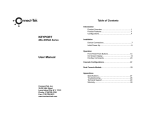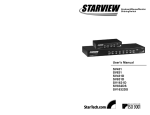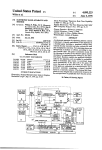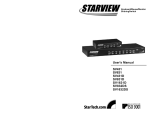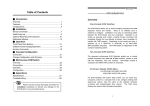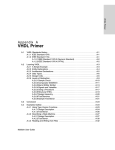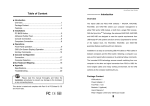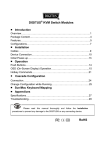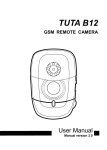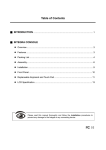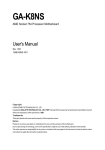Download Table of Contents
Transcript
Table of Contents ■ Introduction Overview ................................................................................. 1 Features .................................................................................. 3 Configurations .......................................................................... 4 ■ Installation Device Connection ................................................................... 7 Initial Power-up ........................................................................ 9 Optional Rack Mount Accessories ............................................. 10 ■ Operation Front Panel Push Buttons ......................................................... 11 OSD (On-Screen Display) Operation ......................................... 12 Hotkey Commands ................................................................... 18 ■ Cascade Configuration Connection .............................................................................. 21 Change Configuration while Running ......................................... 23 ■ Multi-access KVM Switch Overview ................................................................................. 25 Connections ............................................................................. 25 Operation ................................................................................ 25 Configuration ........................................................................... 26 ■ Appendices Specifications ........................................................................... 27 Troubleshooting ....................................................................... 28 Please read this manual thoroughly and follow the Installation procedures to prevent any damage to the KVM Switch or any connecting device. ------------------------ Introduction Overview The KVM Switch allows you to access multiple computers from a set of keyboard, mouse and monitor. There is no interface card or software to configure. Installation is as easy as connecting cables to the KVM Switch and your computers. Operation is as simple as pressing push button, entering hotkey command and navigating through the user-friendly on-screen menu (OSD). It increases the productivity of server and computer management. Depending on the model you have, it switches up to 4 (SW0403C/SW0404C), 8 (SW0802C/SW0803C) or 16 (SW1602C) IBM-compatible computers. The KVM Switch is independent of the computer operating system, allowing the attached computers to run different applications. The advanced multi-access KVM Switches enable you to control multiple computers from two different locations, remote and local with two sets of keyboard, mouse and monitor. On-Screen Display (OSD) Menu For SW0404C, SW0803C, SW0804C SW1602C & SW1603C models For KVM Switches with built-in OSD control, you can name your computers, switch to a desired computer from a list, configure settings with easy-to-use menus, view the name of the selected computer on-screen with programmable time interval, etc. Besides, the OSD displays the system status throughout operation. Improved technology ensures steady OSD menu between computers of different VGA resolutions and smooth switching without leaving OSD garbage characters on the screen. Automatic Mouse Conversion This technology enables you to connect computers with either PS/2 or serial mouse ports to the KVM Switch, and control the computers from one PS/2 mouse. With a special mouse adapter connected to a computer using serial mouse, the KVM Switch automatically identifies the mouse and switches to proper mouse protocol. -1 - High Video Quality This KVM Switch supports VGA resolution up to 1920x1440 without any degradation. Besides, advanced VGA circuit design guarantees smooth and flicker-free switching from one computer to the other with distances up to 100ft (30M)* at both Console and PC sides. NOTE: This User's Manual is written for the following KVM Switches. Console port 1 KVM Switch Models 1 1 2 2 PC port 4 8 16 8 16 No OSD OSD SW0403C SW0404C SW0802C SW0803C SW1602C SW0804C SW1603C * Tested with high-quality UL2919-rated, low -loss, and shielded cables. -2 - Features nSupports both PS/2 and serial mouse nCascade configuration expands system capability nAuto-scan automatically selects computers sequentially nSupports Microsoft IntelliMouse (Pro) nHot-key functions allow easy computer access nKeyboard states automatically saved and restored when switching computers nOperating system independent, transparent to all applications nPlug and play system configuration nKeyboard and mouse can be hot plugged at any time nHigh VGA resolution 1920x1440 nDDC2B compatible nOptional standard 19 inch rack mounting accessories Extra features for On-Screen Display model nAssign computers with unique and meaningful names nIdentify and select computers by the names nProgrammable scan filters unused computers nStore system settings and name entries to non-volatile memory nPassword security locks computer from unauthorized access nGain complete control with easy-to-use OSD interface More features for multi-access models nManage multiple computers from two locations nDifferent Console may have different type of mouse i.e. generic PS/2 mouse and scroll mouse nSelectable User Timeout -3 - Configurations The KVM Switch has several models supporting different number of computers. For applications requiring a large number of computers, KVM Switches can be cascaded in a master/slave configuration to support even more computers to meet the needs of various organizations. Single KVM Switch Configuration Connect a PS/2 keyboard, a PS/2 mouse and a VGA multi-sync monitor directly to the Master’s CONSOLE port. Then, connect multiple sets of keyboard, mouse and monitor cables to the “PC x” ports of the KVM Switch, as shown in figure 1. Figure 1: A single KVM Switch configuration Cascade (Master/Slave) Configuration You can connect a second level of one or more KVM Switches to “PC 1”~”PC 4” (SW0403C/SW0404C) or "PC 1"~”PC 8” ports (SW0802C/SW0803C/SW1602C) of a Master unit. Cascade configuration expands system ability allowing you to select computers connected to the Master or Slaves. There is only one Master, which has a mouse, a keyboard and a monitor connected to its CONSOLE port directly operated by a user. Once connected, KVM Switches automatically configure themselves to either Master or Slave. Slaves of different KVM Switch models can be mixed in cascade configuration. [NOTE: Master must have equal or more PC ports than that of Slaves, i.e., if SW0803C is a master, SW0802C, SW0803C, SW0403C and SW0404C can be Slaves, but SW1602C can not.] -4 - Figure 2: A cascade KVM Switch configuration Throughout this manual, Master is the KVM Switch that has a physical keyboard, mouse and monitor connected to its CONSOLE port. Slave is a KVM Switch that has its CONSOLE port connected to a Master's “PC x” port. Slave only exists in cascade configuration. -5 - -6 - ------------------------ Installation Device Connection The monitor connected to the HDB15 VGA port of a Master CONSOLE must be capable of synchronizing with the computer's video signal. If you are uncertain about the monitor type, please consult the monitor user's manual. Connect a PS/2 mouse and a keyboard to the CONSOLE port marked with a mouse and a keyboard respectively as shown in figure 3. [NOTE: There is no serial mouse for the CONSOLE, just a PS/2 mouse. The KVM Switch's automatic mouse conversion system allows you to connect computers using serial mouse and control the computers from one PS/2 mouse.] Figure 3: Master console connection Determine the channel address of each computer. For computers using PS/2 mouse, connect the computer's mouse and keyboard cables to the KVM Switch’s connectors marked with a mouse and keyboard respectively, as shown in figure 4. -7 - Figure 4: Master computer connection For computers using serial mouse, connect the DB-9 to mini-DIN-6 adapter (comes with the KVM Switch) to the computer mouse port, then use PS/2 cables to connect the mouse to the KVM Switch, see figure 5. Connect the computer's monitor cable to the HDB15 VGA connector. Repeat above steps for all remaining computers to be connected to the KVM Switch. This feature is available for all the ports of a 4-port switch and for 5 ~ 8 ports of an 8/16-port switches. Figure 5: Adapter and serial mouse connection -8 - Initial Power-Up Make sure all computers and KVM Switches are powered down during installation. You must power up the Master KVM Switch before turning on any other devices. 4 For single KVM Switch: Just turn on the KVM Switch by power adapter. 4 For cascade: 1) Apply a power adapter to the Master. 2) Turn on Master's computers. 3) Turn on Slave's computers. This procedure ensures the Master receive computer settings correctly when computer boots. Therefore, the KVM Switch generates correct responses and allows all computers and Slaves to boot successfully without user intervention. Should you decide to expand the system in the future or to replace failed devices, you may hot plug any additional power-downed computer or Slave without turning the Master off. Replace Master Console Devices You can replace a faulty keyboard or mouse of the Master CONSOLE port at any time without powering down the Master, as long as your computers are booted with proper device driver for the new device. Should you encounter any difficulty, just activate K/M RESET by holding the front-panel ‘1’ and ‘2’ push buttons downs for 3 seconds. Adhesive Rubber Foot For desk-top operation, you may stick the four round rubber feet (come with the unit) to the bottom of the KVM Switch. [NOTE: Do not use the rubber feet for rack mount operation.] -9 - Optional Rack Mount Accessories Figure 6 shows how to attach optional mounting brackets to the KVM Switch unit for standard 19-inch rack. Figure 7 shows how to assemble rack cable support then screw it to the back and inside the rack cabinet vertical post. Figure 6: Attaching rack mount bracket Figure 7: Assembling rack cable support Then, keyboard/mouse/monitor cables can be routed over the cable support. You can use plastic cable ties to bundle and label the cables through the rack cable support holes for easy identification. - 10 - ------------------------ Operation Front Panel Push Buttons You may select a computer by pressing the front panel push button directly, by issuing hot-key commands or by activating the OSD window. The front panel indicator changes to reflect the computer port selected (red) and whether the port is connected to a powered computer (green). The indicator flashes red when it is in either Auto Scan or Manual Scan mode. See figure 8 below. Figure 8: Front panel indictor Some computers support 'keyboard/mouse power up' function, i.e., press certain keys or mouse buttons to startup the computers. Their corresponding green front indicators lit all the time even if the computers are 'off'. < K/M RESET K/M RESET is a very handy function that solves most problems developed by keyboard, mouse, device replacement, change of configuration, etc. You may press down both the front-panel number 1 and 2 push buttons for 3 seconds to re-configure the whole system without turning either KVM Switch or any computer off. The end of K/M RESET is recognized when keyboard's Num Lock, Caps Lock and Scroll Lock LEDs flash. < AUTO SCAN The KVM Switch provides an easy to use feature to start Auto Scanning. You can press down both the front-panel number 7 and 8 buttons for 2 seconds to start Auto Scanning. - 11 - OSD (On-Screen-Display) Operation SW0404C, SW0803C, SW1602C SW0804C & SW1603C Figure 9: OSD screen illustration By hitting the left <CTRL> key twice within two seconds, you may see the 'Hotkey Menu' if it is enabled (an OSD option). Or, by hitting the left <CTRL> key three times within two seconds, you will see a 'KVM MENU' screen showing a list of the computers with corresponding port numbers, names and status, see figure 9. The OSD menu of a 4-port KVM switch looks slightly different. The port number of the currently selected computer is displayed in red, same as the front indicator, at the right corner of the OSD menu. - 12 - The color of a device name is green if it has power and is ready for operation, or the color is white as it has no power. OSD menu updates the color when it is activated. The <PageUp> and <PageDown> keys can be used to view 8 other computers at a time, not effective for a 4-port KVM switch. Use the “?“, “?“, “1“ ~ “8“ or “A“ ~ “H“ to highlight a computer and the <ENTER> key to select it. Or, you may press <ESCAPE> to exit OSD and remove the OSD menu from the display; the status window returns to the display and indicates the currently selected computer or operating status. For a 4-port KVM switch, you can only use the “?“ and “?“ arrow keys to highlight a computer. A triangle mark (4) to the right of a name indicates the port is cascaded to a Slave; the number at the left of the triangle mark shows the number of ports the Slave has , i.e. 84for an 8-port switch. <ENTER> key brings you one level down and another screen pops up listing the names of the computers on that Slave. The name of the Slave will be shown at the upper right corner of the OSD menu. It is useful to group computers and still be able to see the group name. An eye mark (N) to the right of a name indicating the computer is selected to be monitored in Scan mode. In OSD, this mark can be switched on or off by function key <F2>. Press <ESCAPE> key to exit OSD and to return to the selected computer; the computer name is also shown on the screen. =Function key <F1>: To edit name entry of a computer or a Slave with up to 14 characters. For 4-port KVM switches, the maximum number of character is 8. First, highlight a port then press <F1> followed by name entry. Valid characters are ‘A’~’Z’, ‘0’~’9’ and the dash character. Lowercase letters are converted to uppercase ones. Press <BACKSPACE> to delete a letter one at a time. Non-volatile memory stores all name entries until you change, even if the unit is powered down. =Function key <F2>: To switch the eye mark (N) of a computer on or off. First, use the <UP> and <DOWN> arrow keys to highlight it, then press <F2> to switch its eye mark on or off. If Scan Type is 'Ready - 13 - PC +N', only the power-on and eye mark selected computers will be displayed sequentially in Scan mode. =Function key <F3>: To lock a computer from unauthorized access. To lock a device, highlight it then press <F3>. Now, enter up to 4 characters (‘A’~’Z’, ‘0’~’9, ‘-‘) followed by <ENTER> as new password. A Security-enabled device is marked with a lock (Ï) following its port number. To permanently disable the security function from a locked device, highlight it, press <F3> then enter the password. For a 4-port KVM switch, only one port can be locked by password. If you want to access the locked device temporarily, simply highlight it and press <ENTER>, the OSD will ask you for the password. After entering the correct password, you are allowed to use the device. This device is automatically re-locked once you switch to another port. During Scan mode, OSD skips the password-protected devices. If you forget the password, the only way to permanently erase all the passwords is to: Press and hold the front panel buttons “1” and “2”, then hold “7” and “8”. Release “7” and “8”, then release “1” and “2”. For 4-port KVM switches: If you forget the password, the only way to permanently disable the security function is to remove all possible power sources from the master KVM switch. You need to turn off all computers and unplug the power adapter, then restart everything. =Function key <F4>: More functions are available by hitting <F4>. A new screen pops up displaying more functions as described below. Most of them are marked with a triangle (4) indicating there are options to choose from. Using the <UP> and <DOWN> arrow keys, select the functions and press <ENTER>. Available options will be shown in the middle of the screen. Again, using the <UP> and <DOWN> arrow keys to view options then press <ENTER> to select it. You can press <ESCAPE> to exit at any time. - 14 - n n n Auto Scan In this mode, the KVM Switch automatically switches from one power-on computer to the next sequentially in a fixed interval. During Auto Scan mode, the OSD displays the name of the selected computer. When Auto Scan detects any keyboard or mouse activity, it suspends the scanning till the activity stops; it then resumes with the next computer in sequence. To abort the Auto Scan mode, press the left <CTRL> twice, or, press any front button. Scan Type and Scan Rate set the scan pattern. Scan Type (<F4>: More\Scan Type) determines if scanned computers must also be eye mark selected. Scan Rate (<F4>: More\Scan Rate) sets the display interval when a computer is selected before selecting the next one. Manual Scan Scan through power-on computers one by one by keyboard control. Scan Type (<F4>: More\Scan Type) determines if scanned computers must also be eye mark selected. Press the up arrow key (↑) to select the previous computer and the down arrow key (↓) to select the next computer. Press any other key to abort the Manual Scan mode. Audio Stick An optional multimedia module can be LINKed to the back of each KVM switch for selecting microphone and stereo speaker signals. There are two options for Audio Stick : ON and Off. When set to 'O n', audio selection follows computer selection. When set to Off', ' audio selection stops following computer selection. It is useful if you want to listen to a particular computer's audio signal while operating other computers. The non-volatile memory stores the Audio Stick setting. - 15 - n Scan Type Ready PC +N : In Scan mode, scan through power-on and eye mark selected computers. Ready PC: In Scan mode, scan through power-on computers. N Only: In Scan mode, scan through any N selected computer regardless of computer power status. This option is not available for 4-port KVM switches. The non-volatile memory stores the Scan Type setting. n n n n Scan Rate Sets the duration of a computer displayed in Auto Scan mode. The options are 3 seconds, 8 seconds, 15 seconds and 30 seconds. The non-volatile memory stores the Scan Rate setting. Keyboard Speed KVM Switch offers keyboard typematic setting that overrides the similar settings in BIOS and in Windows. Available speed options are Low, Middle, Fast and Faster as 10, 15, 20 and 30 characters/sec respectively. The non-volatile memory stores the Keyboard Speed setting. Hotkey Menu When you hit the left <CTRL> key twice within two seconds, the "Hotkey Menu" appears displaying a list of hot-key commands if the option is On. The 'Hotkey Menu' can be turned Off if you prefer not to see it when the left <CTRL> key is hit twice. The non-volatile memory stores the Hotkey Menu setting. CH Display Auto Off: After you select a computer, the port number and name of the computer will appear on the screen for 3 seconds then disappear automatically. Always On: The port number and nam e of a selected computer and/or OSD status displayed on the screen all the time. The non-volatile memory stores the CH Display setting. - 16 - n Position The position of the selected computer name and/or OSD status displayed on screen during operation. The actual display position shifts due to different VGA resolution, the higher the resolution the higher the display position. The non-volatile memory stores the Position setting. Upper Left (UL), Upper Right (UR), Lower Left (LL), Lower Right (LR). Middle (MI). = ESC: To exit the OSD, press the <ESCAPE> key. - 17 - Hotkey commands Hotkey command is a short keyboard sequence to select a computer, to activate computer scan, etc. The KVM Switch interprets keystrokes for hot-keys all the time. A hotkey sequence starts with two left <CTRL> keystrokes followed by one or two more keystrokes. A built-in buzzer generates a high-pitch beep for correct hot-key command; otherwise, one low-pitch beep for error and the bad key sequence will not be forwarded to the selected computer. The short form hot-key menu can be turned on as an OSD function (<F4>: more\Hotkey Menu) every time the left <CTRL> key is pressed twice. L-CTRL: is the <CTRL> key located at the left side of the keyboard. 1~8/A~H: are the number keys '1' ~ '8' at the upper row of the keyboard and character keys 'A' ~ 'H' case insensitive. Do not use the keypad at the right of the keyboard. n To select a computer by hot-key command, you must know its channel address, which is determined by the connection at the back of the KVM Switch. For a computer connected to a Master, its address is represented by the PC port label (1~8 or A~H). For a computer connected to a Slave, two characters represent its address. The first character is the channel address of the Master unit (1~8) and the second one is the channel address of the Slave (1~8 or A~H). Please note that only Master's 'PC 1' ~'PC 8' ports can be connected to a Slave. Left Ctrl + left Ctrl + 7 Selects a computer connected to port 7 of the Master. Left Ctrl + left Ctrl + 6 + C Selects a computer connected to port C of a Slave connected to port 6 of the Master. n To start Auto Scan, automatically scan power-on computers one by one at a fixed interval: left Ctrl + left Ctrl + F 1 When Auto Scan detects any keyboard or mouse activity, it suspends the scanning till activity stops; it then resumes with the next computer in sequence. The length of the Auto Scan interval (Scan Rate) is adjustable, see below. To abort the Auto Scan mode, press the left Ctrl key twice. - 18 - Note: For OSD models, Scan Type determines whether eye mark is necessary during Auto Scan. n Manual Scan enables you to manually switch back and forth between power-on computers. left Ctrl + left Ctrl + F2 Press ↑or ↓to select the previous or the next computer in sequence. And, press any other key to abort the Manual Scan. Note: For OSD models, Scan Type determines whether eye mark is necessary during Manual Scan. n To adjust Scan Rate which sets the duration before switching to the next computer in Auto Scan: left Ctrl + left Ctrl + F3 The KVM Switch sends one to four beeps indicating scan interval of 3, 8, 15 and 30 seconds respectively. n To adjust keyboard typematic rate (characters/sec), this setting over-rides that of BIOS and any operating system: left Ctrl + left Ctrl + F4 The KVM Switch generates 1 to 4 beeps corresponding to 10, 15, 20 and 30 characters/sec respectively. n Audio Stick An optional multimedia module can be LINKed to the back of each KVM Switch for selecting microphone and stereo speaker signals. There are two options for Audio Stick : ON and Off. When set to 'On', audio selection follows computer selection. When set to 'Off', audio selection stops following computer selection. It is useful if you want to listen to a particular computer's audio signal while operating other computers. left Ctrl + left Ctrl + F5 The KVM Switch generates 1 or 2 beeps corresponding to On and Off respectively. - 19 - - 20 - --------------- Cascade Configuration Connection Before connecting a device (a computer or a Slave) to the Master under power, you must turn off the device. The Master must have equal or more 'PC x' ports than that of the Slave, i.e., if an 8-port KVM Switch is the master, 4- or 8-port KVM Switch can be Slaves, but 16-port KVM Switch can not. The ports labeled "PC 1"~”PC 8” can be connected to either a computer or a Slave's CONSOLE port, as shown in figure 10. The ports “PC A"~”PC H” can only be connected to a computer. A power adapter with DC 9V/500mA output rating must be connected to the Master. Figure 10: Slave console connection The maximum number of computers controlled by a master/slave configuration with all SW0403C and SW0404C is 16 with 4 Slaves and each Slave connects to 4 computers, see figure 11. For an all SW0802C/SW0803C configuration, the number is 64 with 8 Slaves and each Slave connects to 8 computers, see figure 12. For an all SW1602C configuration, the number is 136, see figure 13. The Master SW1602C connects to 8 Slaves and 8 computers, and each Slave connects to 16 computers. - 21 - Figure 11: Cascaded 4-port KVM Switches Figure 12: Cascaded 8-port KVM Switches Figure 13: Cascaded 16-port KVM Switches - 22 - For OSD model: After connection completes, you should re-activate the OSD menu to check if the Master recognizes the Slaves. A triangle mark (4) is placed to the right of the channel name indicating the port is connected to a Slave not a computer. A number to the left of the triangle mark indicates the Slave model, i.e. 84 for SW0802C or SW0803C. Change Configuration while Running Devices at any 'PC x' port can be changed at any time after initial power-up. If you change any one of the “PC 1” to “PC 8” ports connection from a computer to a Slave or vice versa, or replace the devices of a port; the OSD will update this change the next time it is activated. [NOTE: Any new device, a computer or a Slave, must be turned off before it is connected to the Master.] - 23 - - 24 - ------------------ Multi-access KVM Switch SW0804C & SW1603C Overview The advanced multi-access SW0804C and SW1603C have all the features of SW0803C and SW1602C respectively. Both models have two Console ports facilitate you to access multiple computers from two different locations, local and remote. Thanks to the high-drive circuit design, you may connect high quality cables at Console and PC sides for up to 100ft (30M), a definite plus for server room applications. Now you can access all computers either in the server room when you have to physically access the computers such as software upgrade, or away from the server room for everyday use. Connections: Connect two sets of keyboards, mice and monitors to the two CONSOLE ports. The built-in PS/2 mouse signal translation enables you to connect PS/2 mice of different type to the CONSOLE ports, i.e., a generic PS/2 mouse for one CONSOLE and a scroll mouse for another. Operation: On power up, the SW0804C and SW1603C are in Idle mode broadcasting VGA signal from the selected computer to both CONSOLEs and detecting for keyboard and mouse activity at both CONSOLEs. User LEDs (marked with reverse white A and B) are both red indicating the KVM Switch is not in use. - 25 - When either keyboard or mouse activity is detected at one CONSOLE, the KVM Switch immediately disables the other CONSOLE from accessing the computer. Only one User LED, at the front panel, remains lit indicating the KVM Switch is under user operation. In the mean time, keyboard LEDs (Num/Caps/Scroll Lock) of the other CONSOLE start to flash as its access is denied and the monitor is blocked from VGA signal for security reason. After the user has finished his operation for a period of time (i.e., User Timeout), the multi-access KVM Switch returns to Idle mode. User Timeout has four options, 5 sec, 30 sec, 60 sec and HOLD. Select HOLD when you plan to access the KVM Switch for a long time. Pressing the <Scroll Lock> twice forces the KVM Switch return to Idle mode immediately regardless of the User Timeout setting. The User Timeout is available in the OSD menu by pressing the Function key <F4>, under the sub-menu More. [Note: Keyboard Speed option is not available for multi-access models.] Configuration: To expand the number of computers under control, you may connect CONSOLE port of another KVM Switch to "PC 1" ~ "PC 8" port of the SW0804C and SW1603C. Refer to the chapter Cascade Configuration for more details. There are rules to apply for Master/Slave configuration. When SW0804C is a Master, its slave includes SW0403C, SW0404C, SW0802C and SW0803C. When SW1603C is a Master, its slaves includes all the above and SW1602C. Since SW0804C and SW1603C already come with OSD menu, their Slaves do not have to be OSD equipped. For maximum capacity of SW0804C, refer to figure 12 and replace the Master with SW0804C. Likewise, change the Master in figure 13 to SW1603C for its maximum capacity. - 26 - ------------------------ Appendices Specifications: SW0802C SW0803C 1 SW1602C SW0804C User port number SW0403C SW0404C 1 1 2 2 Computer port number 4 8 16 8 16 Cascade control PC number On-screen display (OSD) Up to 16* SW0404C Up to 64* SW0803C Up to 136* Up to 64* Yes Up to 136* Front panel button control 4 8 16 8 16 RMK08 RMK16 Specifications Hot plug-and-play Hotkey control SW1603C Yes Yes Rack-mount kit RMK04 Automatic scan interval Programmable scan pattern SW0404C RMK08 RMK16 3, 8, 15, 30 seconds SW0803C Yes Year 2000 compliant Yes Cable length (Max) VGA 30M (100ft) at CONSOLE 30M (100ft) at PC ports 1920 x 1440, DDC2B keyboard Computer mouse connector monitor PS/2 PS/2, serial (with adapter) HDB15 male keyboard Console mouse connector monitor H x W x D (mm) (in.) size PS/2 PS/2 HDB15 female 44x220x130 44x436x180 88x436x220 44x436x180 88x436x220 1.7x8.7x5.1 1.7x17.2x7.0 3.5x17.2x8.7 1.7x17.2x7.0 3.5x17.2x8.7 Compact 1U 2U 1U 2U Power supply (min) 9V DC, 500mA * Cascaded with the same model of KVM Switches. If other models (SW0403C, SW0404C, SW0802C, SW0803C and SW1602C) are cascaded, you can control up to 136 computers. - 27 - Troubleshooting: Ensure that all cables are well seated. Check that keyboard/mouse cables are not swapped. Label and bundle the cables for each computer to avoid confusion when connected to the KVM Switch. Symptom Possible causes Fuzzy image monitor on .Loose cable .VGA setting is too high .Loose power adapter No OSD screen Keyboard error on boot Master/slave does not work Keyboard shifted strokes The↑ and ↓ keys do not work in Manual Scan Mouse does work properly not Recommended solutions .Secure all VGA cables .Lower the VGA resolution setting, refresh rate and use low -loss, shielded cables .Secure power adapter .No power to KVM Switch .Establish power by turning on computers, wait, press left CTRL .Loose monitor keys several times. connection .Reconnect monitor .Monitor not multi-sync .Use multi-sync monitor .Loose keyboard .Make sure keyboard cables are connection Well seated .Improper installation .Make sure slave’s CONSOLE is procedures connected to Master’s PC 1~ PC 8 port .Press and hold the 1 and 2 push buttons to initiate K/M RESET .Remove any possible power supply to the slave (unplug all cables), before connecting it to the Master .The computer was in .Press both SHIFT keys shifted state when last switched .All PCs are off or only .Turn computers on. one PC is turned on. Scan mode works for .Press any other key to abort power-on computers only Manual Scan mode. .Scan type is eye mark .Set proper Scan type in OSD and selected but no PC is eye determine which PCs are eye mark selected in OSD. mark selected, do it in OSD. .Improper mouse drive .Make sure you have the latest .Non-ps/2 mouse mouse driver and only one driver installed. .Use standard PS/2 mouse or Intellimouse. Some scroll mouse, dual-wheel mouse,4-button mouse, cordless mouse are not PS/2 standard. .Remove any mouse driver from config. Sys or autoexec.bat. - 28 - Auto Scan does not switch PC and KVM Switch beeps from time to time and red indicator flashes .All PCs are off or only one PC is turned on. Scan mode works for power-on computers only .Scan type is eye mark selected but no power-up PC is eye mark selected in OSD. .Double OSD images .Improper slave at cascade connection procedure. configuration OSD menu is not at .OSD menu has fixed the proper position resolution and its size varies due to different computer VGA resolution. Computer can not .Loose mouse adapter use serial mouse .Incorrect mouse adapter Can not select a .Improper Master unit computer connected connection to a slave .Improper slave unit connection .Too many levels of slaves The KVM Switch .Computers do not supply fails to function enough power. occasionally. - 29 - .Turn on computers .Set proper Scan Type in OSD and determine which PCs are eye mark selected, do it in OSD. .Press left CTRL key twice to abort Auto Scan mode. .Press any front button to select a PC, and Auto Scan stops. .Press push buttons 1 and 2 down for 3 seconds to activate K/M RESET. . Remove any possible power supply to the Slave (unplug all cables), before connecting it to the Master. .Use <F4>:More\Position to select UL or UR. OSD menu may appear near the middle of the screen when LL or LR is selected. .Secure the mouse adapter to computer’s COM port .Use only the mouse adapter comes with the unit .Only Master ports PC1~PC8 can be connected to slaves. .Connect slave CONSOLE port to PC1~PC8 ports of the Master .Only one level of slave units is allowed. Pop up OSD again to check if Master recognizes the slave connection. Look for triangle mark and the number before it. .Add a power adapter with minimum of 9V DC 500mA output rating to the SPARE power jack. FCC Statement This equipment has been test and found to comply with the limits for a Class B digital device, pursuant to part 15 of the FCC Rules. These limits are designed to provide reasonable protection against harmful interference in a residential installation. This equipment generates, uses and can radiate radio frequency energy and, if not installed and used in accordance with the instruction, may cause harmful interference to radio communications. However, there is no guarantee that interference will not occur in a particular installation. If this equipment does cause harmful interference to radio or television reception, which cab be determined by turning the equipment off and on, the user is encouraged to try to correct the interference by one or more of the following measures: -Reorient or relocate the receiving antenna. -Increase separation between the equipment and receiver. -Connect the equipment into an outlet on a circuit different from that to which the receiver is connected. -Consult the dealer or an experienced radio technician for help. Limited Warranty IN NO EVENT SHALL THE DIRECT VENDOR'S LIABILITY FOR DIRECT OR INDIRECT, SPECIAL, INCIDENTIAL OR CONSEQUENTIAL DAMAGES, LOSS OF PROFIT, LOSS OF BUSINESS, OR FINANCIAL LOSS WHICH MAY BE CAUSED BY THE USE OF THE PRODUCT EXCEEDS THE PRICE PAID FOR THE PDOCUDT. The direct vendor makes no warranty or representation, expressed or implied with respect to the contents or use of this documentation, and especially disclaims its quality, performance, merchantability, or fitness for any particular purpose. The direct vendor also reserves the right to revise or update the product or documentation without obligation to notify any user of such revisions or updates. For further information, please contact your direct vendor. All the brand names and registered trademarks are the property of their respective owners. PP5-N0100-307 Printed in Taiwan
































